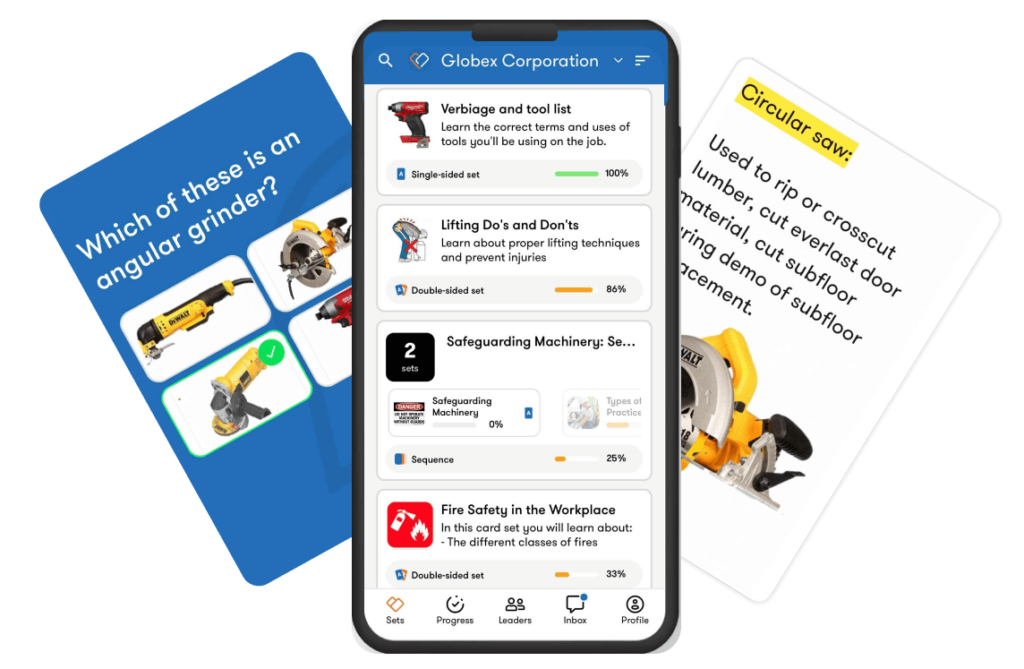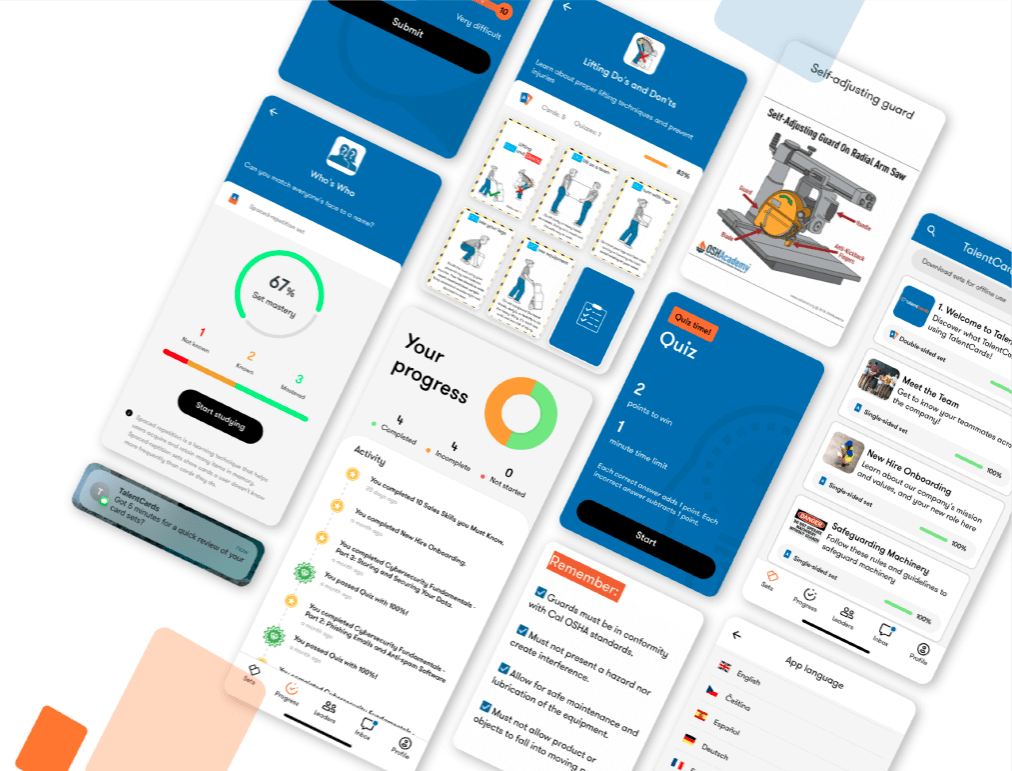While having your morning coffee and going through a mountain of work emails, you find a new policy update and wonder, “Didn’t we go over this last year?” Yes, you did. But it’s time for a review and update. That’s when refresher training comes in. It helps reinforce what you already know and adds any new information you need to stay updated.
Here, we’ll peel back the layers of refresher training. It’s more than a simple review session. It acts as a bridge connecting past learning with present demands. Maintaining a solid foundation of skills means your staff is ready to tackle new challenges that come their way.
Why does this matter? In a world where change is the only constant, staying sharp, skilled, and agile isn’t just nice to have; it’s essential.
- What is refresher training?
- What is a basic training refresher?
- How often should refresher training take place?
- Why is annual refresher training important?
- Benefits of refresher training
- Examples of refresher training
- Implementing effective refresher training
- Tips for engaging employees and measuring success
- FAQs
- Key takeaways
What is refresher training?
Refresher training helps experienced employees brush up on their skills and knowledge. It’s shorter than initial training, focusing on updating and reinforcing what they might have forgotten. This keeps everyone sharp, up-to-date with industry standards, and working efficiently. It boosts productivity and work quality while ensuring compliance and safety. Depending on the needs, it can vary in form and is often offered through online platforms.
In the rapidly changing landscape, what was known yesterday might not be enough to navigate today’s challenges or tomorrow’s opportunities. Refresher training keeps everyone on track. It ensures that your staff isn’t just maintaining their skill levels. They’re enhancing what they know to contribute more effectively to their roles.
What is a basic training refresher?
A basic training refresher focuses on the crucial skills and knowledge employees need. It’s a targeted approach to ensure everyone remains proficient and compliant. This type of training covers essential procedures, safety protocols, and fundamental operational tasks that form the bedrock of daily work activities.
This process acts as a recalibration of your team’s capabilities, sharpening the essential tools and methods they rely on. Its value shines in reinforcing key practices, especially those tied to safety and regulatory compliance.
By honing in on these fundamental components, basic refresher training establishes a uniform level of skill and knowledge across your team. This uniformity is crucial for minimizing mistakes and boosting overall efficiency. The training aligns everyone’s efforts, from updates on the latest safety protocols to revisiting customer service basics or familiarizing themselves with new tech tools. With it, you promote a cohesive, safe, and productive work environment.
How often should refresher training take place?
Deciding on the frequency of refresher training depends on several factors.
Consider:
- The nature of your industry
- Your business’s specific needs
- Legal requirements
Generally, scheduling refresher training at least annually is a good idea. However, the “one size fits all” approach doesn’t always apply. Some industries require more frequent updates. Conducting training sessions every six months or quarterly can be beneficial.
Keep a close eye on your team’s needs. If they find new processes or tools challenging, it’s time to schedule a refresher. The aim is to keep everyone sharp, safe, and up-to-date. Providing the right training helps them excel with the necessary tools and knowledge.
Why is annual refresher training important?
Annual refresher training is critical for sustaining a proficient, safe, and compliant workforce. This importance is magnified when we consider the natural tendency of humans to forget over time. This phenomenon is known as the Ebbinghaus Forgetting Curve.
In the 1880s, a German psychologist named Hermann Ebbinghaus uncovered new information about how we retain information. He found that an hour after learning something new, we’ll likely forget half of it.
Fast forward to a day later, and that figure could rise to 70%. By the time a week has passed, just 25% of the original information remains.
This phenomenon highlights the importance of reinforcing learning.
Beyond combating forgetfulness, annual refresher training serves several key functions. It ensures employees’ skills align with current industry standards and regulatory requirements.
For example, industries with strict safety and compliance regulations—like healthcare, food and beverage, and manufacturing—require ongoing training. Some industries must adhere to OSHA standards. For those, annual safety training is a legal requirement.
Annual refresher training isn’t just a regulatory requirement or a tool to mitigate the forgetting curve. It’s a strategic investment in your organization’s most valuable asset—your people. Through this investment, you can ensure your workforce remains capable, confident, and competitive over time.
Benefits of refresher training
Refresher training is not just a routine part of employee development; it’s a strategic tool that offers multiple benefits for employees and the organization.
Here are some key advantages:
- Increased productivity
Regular updates and refreshers help employees work more efficiently, directly impacting overall productivity. - Improved performance
Employees with reinforced skills and knowledge can perform their tasks more effectively, leading to higher-quality work. - Compliance with safety standards
Ensuring employees are current with safety protocols minimizes risks and helps meet industry regulations. - Fostering a culture of continuous learning
Regular training reinforces the importance of learning and growth. Staff is more likely to actively seek out new knowledge and skills. - Improved employee retention
When companies invest in their employees’ development, they feel more valued and supported. This builds loyalty and reduces turnover.
Examples of refresher training
Refresher training can take many forms. Each is tailored to organizational needs, skill sets, and compliance requirements.
Here are some concrete examples:
- Safety protocols and compliance: Annual sessions on workplace safety standards, emergency procedures, and compliance ensure a safe working environment.
- Technology updates: Training on the latest software tools, platforms, or equipment being introduced to keep employees adept at using new technologies
- Customer service excellence: Reinforce best practices in customer interaction, handling difficult situations, and providing exceptional service.
- Quality control: Maintain quality with the latest industry standards and company-specific quality assurance processes.
- Leadership and management skills: For supervisory roles, refresher courses on leadership principles, conflict resolution, team management, and effective communication.
Implementing effective refresher training
Designing and rolling out an effective refresher training program requires a strategic approach. Here are key strategies to consider:
1. Assess needs
Start by identifying the specific skills and knowledge areas that need refreshing. This can be done through performance reviews, feedback sessions, and analyzing industry trends.
2. Set clear objectives
Once you know what needs refreshing, set tangible goals for your training. What specific skills or knowledge should your employees come away with? How will this training contribute to your overall business objectives?
3. Choose the right format
Depending on the content, audience, and logistics, decide whether e-learning, microlearning, or in-person sessions would be most effective.
4. Engage learners with interactive content
Use interactive elements like quizzes, simulations, gamification elements, and group discussions to make the training engaging.
5. Schedule strategically
Plan sessions at times that minimize disruption to daily operations. For critical updates, ensure training is timely.
6. Implement the training
Roll out your training program, ensuring all employees can access the necessary resources and support to engage fully with the material.
7. Track progress and feedback
Implement a system to track completion and assess the impact of training. Use feedback to refine future sessions, making them more relevant and impactful.
Make refresher training easily accessible with a powerful mobile app

Tips for engaging employees and measuring success
- Make it interactive: Use quizzes, group discussions, and simulations to keep your team engaged. Adult learners often benefit from active participation more than passive listening.
- Link training to career development: Keeping training relevant to the learner matters. Show your team how this refresher training can help them grow in their roles or prepare for future opportunities. This can boost motivation and engagement.
- Use technology to your advantage: Mobile training platforms, like TalentCards, can make training more accessible and engaging. Consider using one to deliver content in a flexible, user-friendly format.
- Measure impact: To understand the effectiveness of your training, look at performance metrics before and after the sessions. Surveys, quizzes, and observation can also provide insights into how well the material was absorbed.
- Reward participation: Recognize and reward engagement and improvement post-training. This could be through certificates, badges, or even spot bonuses. Recognition encourages continuous learning and improvement.
Implementing a well-crafted refresher training program requires effort. Yet, the payoff is significant. More knowledgeable and engaged employees, improved performance, and stronger alignment with industry standards are all within reach.
FAQs
Why is annual refresher training important?
Annual refresher training ensures skills stay current and comply with evolving industry regulations. It keeps the workforce agile and prepared for new challenges.
What is the meaning of a refresher course?
A refresher course is a time for staff to revisit essential knowledge and skills. They may also be updated on new standards.
How often should refresher training take place?
The frequency depends on the industry, job role, and regulatory requirements. Typically, it’s annually, but some industries may require more frequent updates.
What is a basic training refresher?
Basic training refresher covers foundational skills and knowledge necessary for effective job performance. It ensures all employees meet a consistent competency level.
Refresh your training with a mobile platform
Keeping your workforce skilled, informed, and agile is crucial in today’s fast-changing business world. An effective refresher training program keeps you compliant and safe while promoting ongoing improvement and excellence.
What’s the best way to reach your staff on the go? By leveraging the power of mobile learning. With it, you can deliver bite-sized, impactful training directly to your employees. Enhance performance, engagement, and compliance by keeping them ahead of the curve.
Key takeaways
- Refresher training reinforces existing knowledge and skills, ensuring staff remains sharp and ready for their roles.
- Regular refresher training and practicing active recall helps employees stay aligned with the latest industry standards.
- Given the natural tendency to forget information over time, periodic refresher courses are vital for sustaining knowledge and preventing skill loss.
- Regular training initiatives underscore the importance of ongoing professional development, encouraging a workplace environment that values growth and adaptability.
Make refresher training conveniently accessible with a mobile training app



